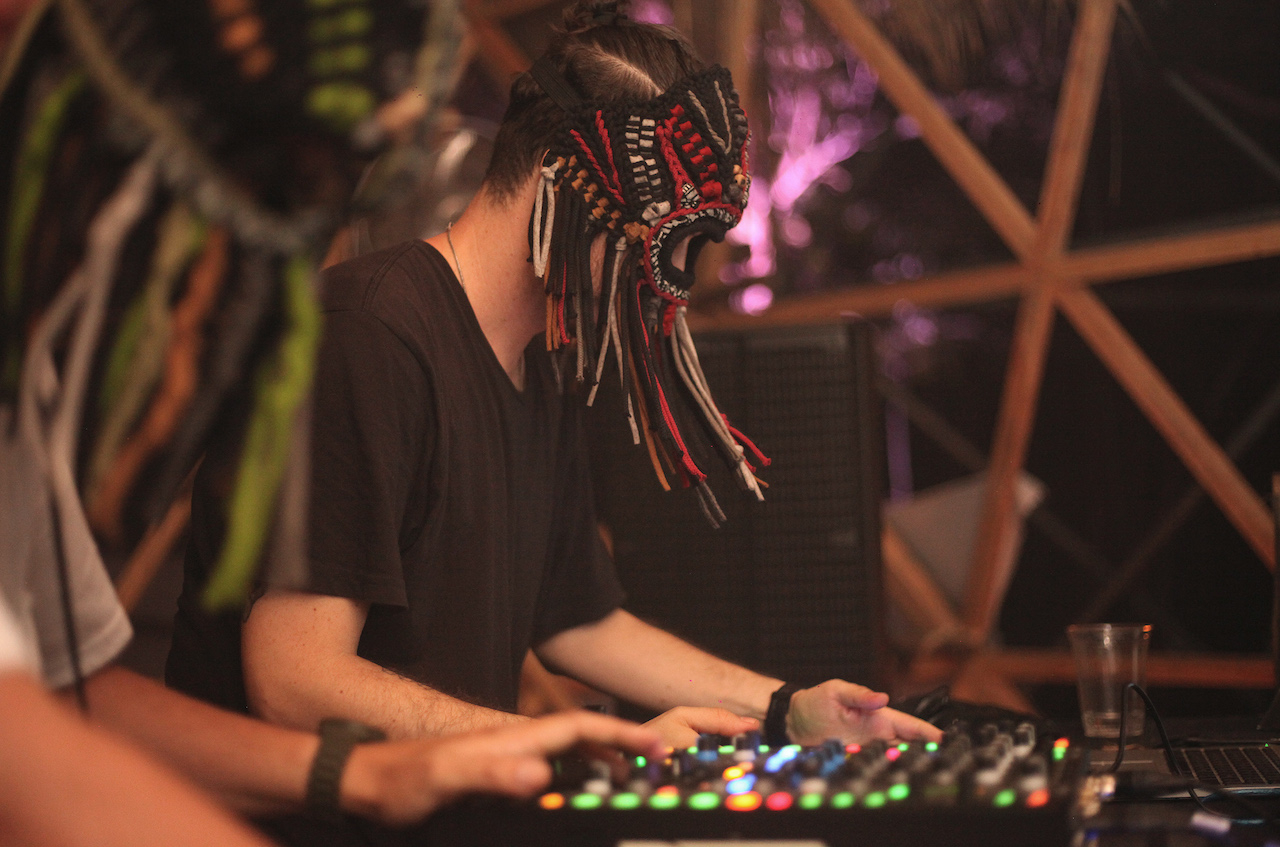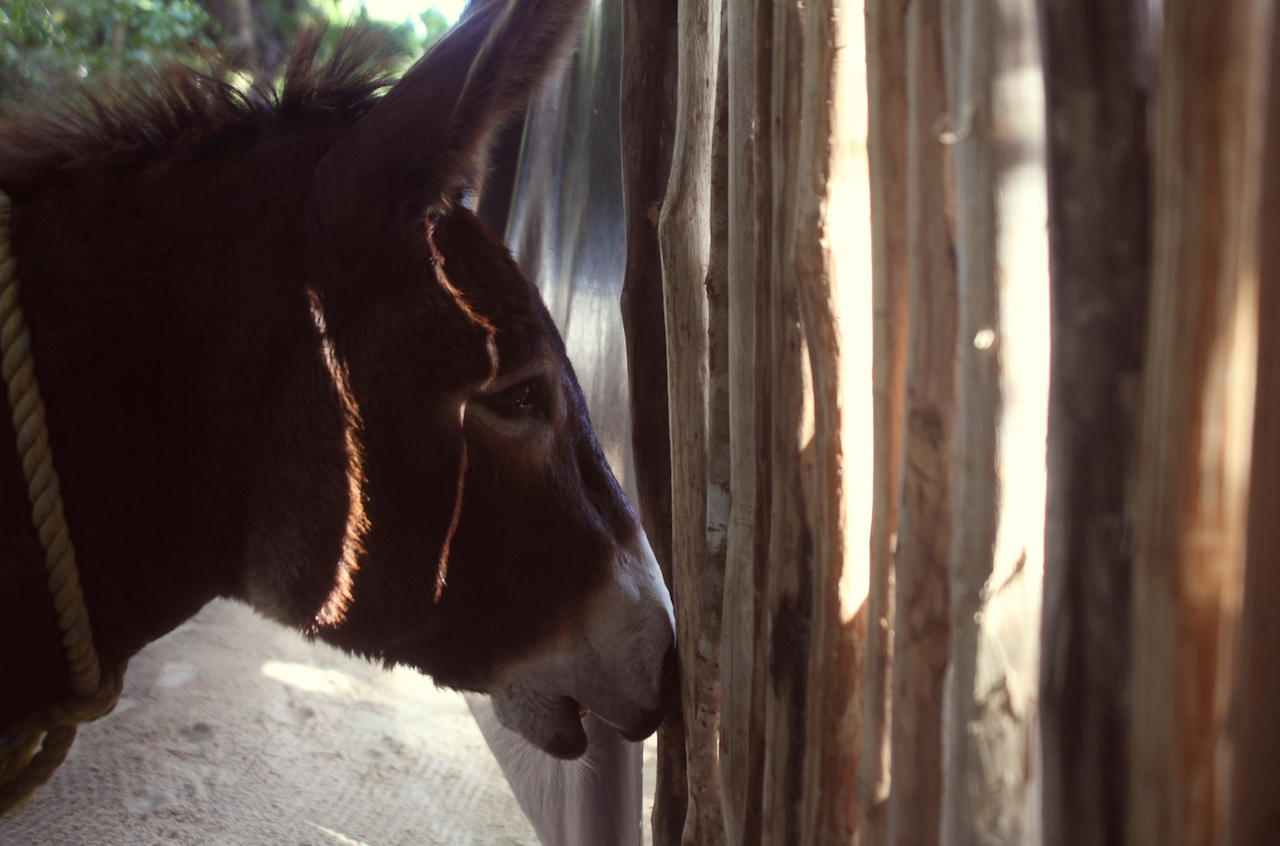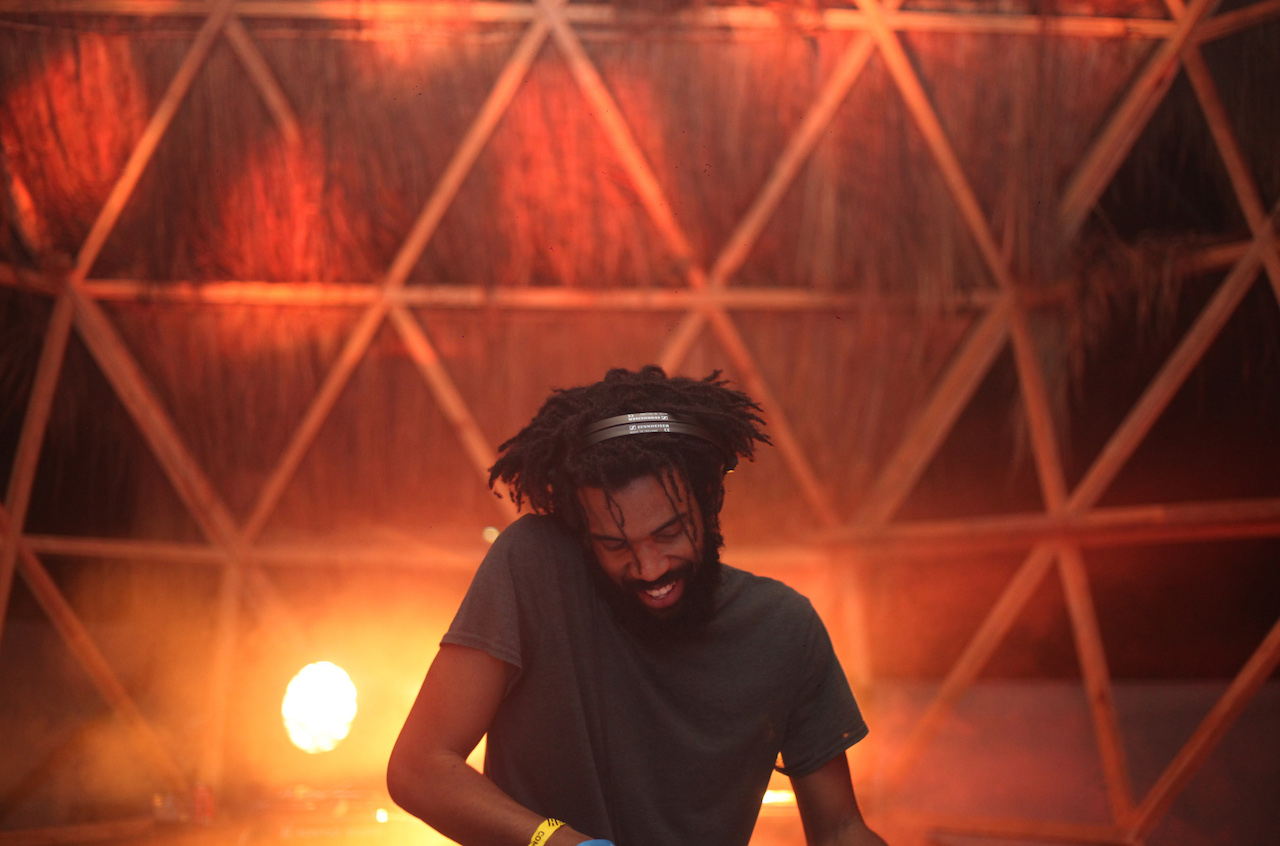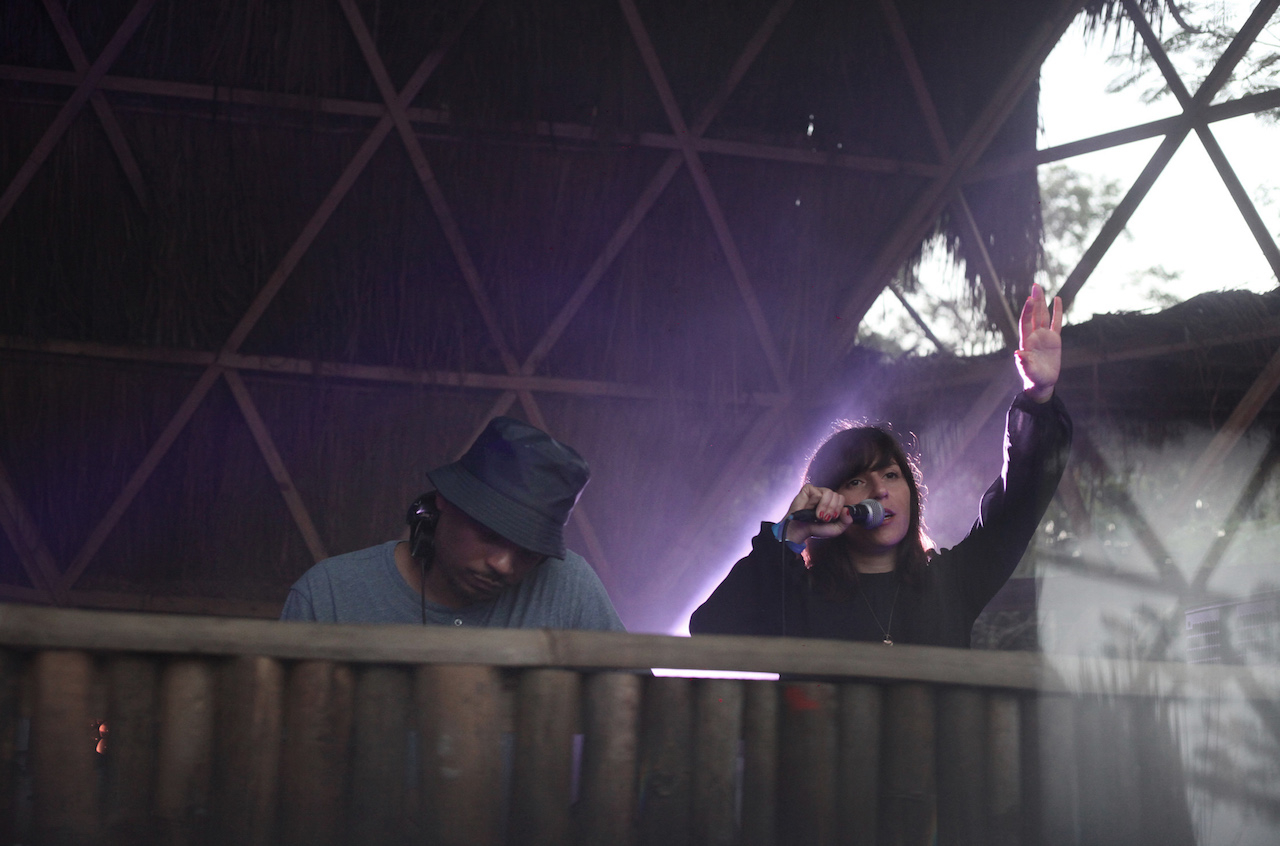- Tulum is a two-road beach town that straddles the tip of Mexico's Yucatan Peninsula. Sandwiched between the Caribbean Sea and a sprawling nature reserve, it's a tranquil, lifestyle-conscious alternative to nearby tourist destinations like Playa Del Carmen or Cancun. People come for the eco-friendly boutique hotels, week-long yoga retreats and—of course—the exquisite white sand beaches with water the color of precious stones. A couple kilometers into the jungle is where you'll find Comunité, a 24-hour electronic music marathon that returned for round two last weekend with an expanded lineup and a new venue. The house-heavy bill included Sonja Moonear, Fred P, a Giegling showcase and Omar-S's debut live performance alongside LA singer and producer Nite Jewel. The weekend's real headliner, though, was Parque Dos Ojos.
My friends and I pulled into the park around midday so we could beat everybody else to the cenote. Cenotes, for those who don't know, are the points at which the huge underground river coursing through the crust of the Yucatan breaks through to the light of day. The Mayans said they were portals to the underworld, and today they take the form of lakes, ponds, sink holes or, like the one that split the earth between the two stages at Comunité, submerged caves that connect to a wider system of flooded tunnels. A rock basin flooded with clear blue water was protected by an overhang of stalagmite columns. A wooden dock had been fitted that gave way to a jungle path. Mexican selector Sakro played swinging, bass-heavy house on the smaller stage as the pool filled with well-dressed party people. Small bat shadows darted around the walls of the cave.
Tulum has built its name on a blend of eco-consciousness, healthy-living chic and a touch of new age woo-woo. Comunité, appropriately, boasted an entirely vegan spread of food vendors, a leave-no-trace trash policy and stalls selling jewelry made from semi-precious stones and crystals. The main stage was flanked by wooden planks painted with I Ching characters—"community," "communication," "union" and "communion." The crowd, which skewed towards hedonistic Europeans on holiday, felt incongruous with the crunchy granola aesthetic. That said, the festival's do-good values provided partiers with a much-needed nudge to stay on their best behavior.
As night fell, the noises from the jungle intensified. Things got cooking on the main stage with a live set from Peruvian duo Dengue Dengue Dengue, who merge traditional Afro-Latin music with percussion-heavy electronics. Their set swung across a wide range of rhythms, with a playful arc united by rich organic samples, interlocking rhythms and huge sub-bass. Project Pablo followed up, keeping the crowd smiling with his infectious, cheerful house sound. He rep'ed hard for Canadian labels like Mood Hut, 1080p and his own Beaubien Ouest, easing the crowd into rave mode with freewheeling synths and syncopated garage rhythms.
The pacing was gentler over at the intimate second stage, an amphitheater built into a clearing. As I made my way over on a low-lit dirt path, I could hear flourishes of synths climbing up and down in chaotic free jazz scales. It was Ambiq, a live trio led by German producer Max Loderbauer. What I was hearing was a modified clarinet matched by modular synths and an extremely on-point drummer. They anchored their improvisational madness in precise rhythms and ultra-sparse dub basslines, and the heady psychedelia of their show provided a nice punctuation mark in the phrasing of a very long night.
At 1 AM everything began to move faster. It was already nine hours into the festival—not even halfway—and when I woke from a hazy power nap under a fig tree, Kyle Hall was on the main stage. His vocal-heavy house selections sounded sharp on the festival's formidable rig, as he moved easily between R&B and soul-inflected tracks like Seven Davis Jr.'s "Soul Music" and Doc Link's "Sugar." New York's Fred P followed up with the night's most impressive set, a three-hour tour de force that rarely loosened its grip on the audience. His selections struck a balance between otherworldly sci-fi textures and irresistible grooves. Every few songs he'd let it rip on some piano house banger or a sing-along soul tune before bringing it back into something more subtle. He passed the baton over to Omar-S and Nite Jewel with RH Factor's "Universe", a joyful house cut with jazz-fusion chord changes and a lot of trumpet.
Omar-S and Nite Jewel—for many the festival's most anticipated booking—didn't blow the roof off the place. It was cool to see the Detroiter working a hardware sequencer, banging out live versions of his tracks, but sparks didn't fly when Nite Jewel got on the mic. She's put out a handful of strong records on her own, but here she came off rigid and uneasy. Her attempts at hyping the crowd didn't have much traction, and their closing track, a throwback pop number called "Sky Train," left things on an especially cheesy note.
I'd been standing for 19 hours by then, which meant that Giegling's afternoon showcase was not on the cards. As I made my way to the car, I took a look back and realized there were almost double as many dancers at 8 AM as there had been 12 hours earlier. There were club kids I recognized from Mexico City, jet-setting Ibiza types in white linen and low-budget backpackers, all dancing in the sticky jungle humidity. It's testament to the strength of the event that, only two years in, they were able to pull a crowd from so many different walks of life. Destination parties like Comunité have proliferated in the last few years, and there's plenty of warm-weather options for techno tourists who can afford it. In terms of the setting's splendor and the team's inventive programming, it's hard to match what Comunité has on offer.
Photo credit /
Erez Avissar

 The pacing was gentler over at the intimate second stage, an amphitheater built into a clearing. As I made my way over on a low-lit dirt path, I could hear flourishes of synths climbing up and down in chaotic free jazz scales. It was Ambiq, a live trio led by German producer Max Loderbauer. What I was hearing was a modified clarinet matched by modular synths and an extremely on-point drummer. They anchored their improvisational madness in precise rhythms and ultra-sparse dub basslines, and the heady psychedelia of their show provided a nice punctuation mark in the phrasing of a very long night. At 1 AM everything began to move faster. It was already nine hours into the festival—not even halfway—and when I woke from a hazy power nap under a fig tree, Kyle Hall was on the main stage. His vocal-heavy house selections sounded sharp on the festival's formidable rig, as he moved easily between R&B and soul-inflected tracks like Seven Davis Jr.'s "Soul Music" and Doc Link's "Sugar." New York's Fred P followed up with the night's most impressive set, a three-hour tour de force that rarely loosened its grip on the audience. His selections struck a balance between otherworldly sci-fi textures and irresistible grooves. Every few songs he'd let it rip on some piano house banger or a sing-along soul tune before bringing it back into something more subtle. He passed the baton over to Omar-S and Nite Jewel with RH Factor's "Universe", a joyful house cut with jazz-fusion chord changes and a lot of trumpet.
The pacing was gentler over at the intimate second stage, an amphitheater built into a clearing. As I made my way over on a low-lit dirt path, I could hear flourishes of synths climbing up and down in chaotic free jazz scales. It was Ambiq, a live trio led by German producer Max Loderbauer. What I was hearing was a modified clarinet matched by modular synths and an extremely on-point drummer. They anchored their improvisational madness in precise rhythms and ultra-sparse dub basslines, and the heady psychedelia of their show provided a nice punctuation mark in the phrasing of a very long night. At 1 AM everything began to move faster. It was already nine hours into the festival—not even halfway—and when I woke from a hazy power nap under a fig tree, Kyle Hall was on the main stage. His vocal-heavy house selections sounded sharp on the festival's formidable rig, as he moved easily between R&B and soul-inflected tracks like Seven Davis Jr.'s "Soul Music" and Doc Link's "Sugar." New York's Fred P followed up with the night's most impressive set, a three-hour tour de force that rarely loosened its grip on the audience. His selections struck a balance between otherworldly sci-fi textures and irresistible grooves. Every few songs he'd let it rip on some piano house banger or a sing-along soul tune before bringing it back into something more subtle. He passed the baton over to Omar-S and Nite Jewel with RH Factor's "Universe", a joyful house cut with jazz-fusion chord changes and a lot of trumpet. Omar-S and Nite Jewel—for many the festival's most anticipated booking—didn't blow the roof off the place. It was cool to see the Detroiter working a hardware sequencer, banging out live versions of his tracks, but sparks didn't fly when Nite Jewel got on the mic. She's put out a handful of strong records on her own, but here she came off rigid and uneasy. Her attempts at hyping the crowd didn't have much traction, and their closing track, a throwback pop number called "Sky Train," left things on an especially cheesy note. I'd been standing for 19 hours by then, which meant that Giegling's afternoon showcase was not on the cards. As I made my way to the car, I took a look back and realized there were almost double as many dancers at 8 AM as there had been 12 hours earlier. There were club kids I recognized from Mexico City, jet-setting Ibiza types in white linen and low-budget backpackers, all dancing in the sticky jungle humidity. It's testament to the strength of the event that, only two years in, they were able to pull a crowd from so many different walks of life. Destination parties like Comunité have proliferated in the last few years, and there's plenty of warm-weather options for techno tourists who can afford it. In terms of the setting's splendor and the team's inventive programming, it's hard to match what Comunité has on offer. Photo credit / Erez Avissar
Omar-S and Nite Jewel—for many the festival's most anticipated booking—didn't blow the roof off the place. It was cool to see the Detroiter working a hardware sequencer, banging out live versions of his tracks, but sparks didn't fly when Nite Jewel got on the mic. She's put out a handful of strong records on her own, but here she came off rigid and uneasy. Her attempts at hyping the crowd didn't have much traction, and their closing track, a throwback pop number called "Sky Train," left things on an especially cheesy note. I'd been standing for 19 hours by then, which meant that Giegling's afternoon showcase was not on the cards. As I made my way to the car, I took a look back and realized there were almost double as many dancers at 8 AM as there had been 12 hours earlier. There were club kids I recognized from Mexico City, jet-setting Ibiza types in white linen and low-budget backpackers, all dancing in the sticky jungle humidity. It's testament to the strength of the event that, only two years in, they were able to pull a crowd from so many different walks of life. Destination parties like Comunité have proliferated in the last few years, and there's plenty of warm-weather options for techno tourists who can afford it. In terms of the setting's splendor and the team's inventive programming, it's hard to match what Comunité has on offer. Photo credit / Erez Avissar